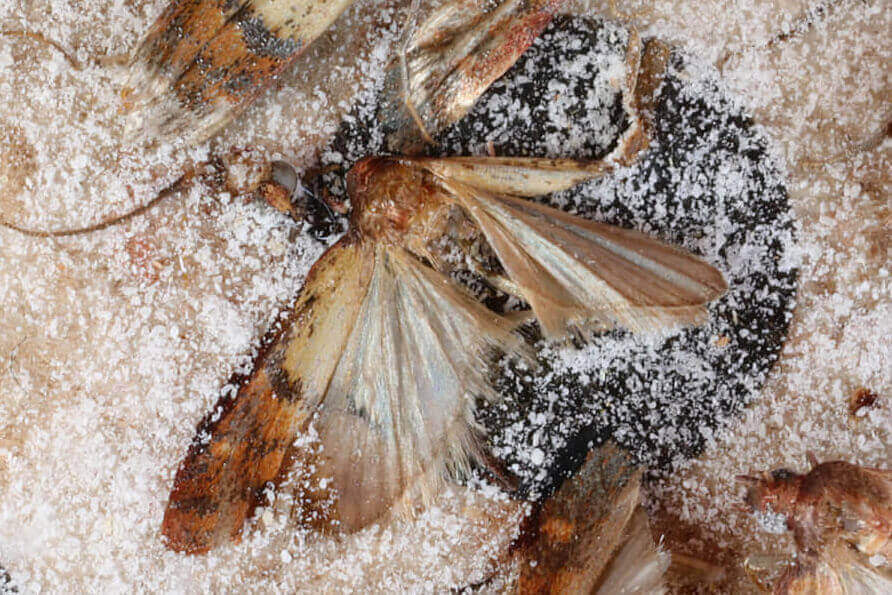Pantry Moth Facts & Information
Everything you need to know about pantry moths
What do Pantry Moths look like

While they do look like clothes moths, there are some distinctive features that make pantry moths stand out. With a wingspan of 5/8-inch, they are pretty small. Their wings have a pale greyish tint, and some outer wings are more reddish brown. A black band connects the upper and lower wings. Because they’re so small it’s easy to overlook pantry moths until your kitchen storage space is overwhelmed by them.
Pantry moths are found almost everywhere in the U.S. These pests will feed on almost any dry foods, especially raw and processed grain products, cereals, pastas, and dog and cat food. An infestation is not a sign of your own poor housekeeping, because in most cases the initial infestation occurs at a commercial food processing or packaging facility and comes into your home from packaged foods.
The hundreds of tiny white eggs laid by adult female moths will hatch in a few days into small white caterpillar larvae, less than 1/2 inch long, which spend the next several weeks spinning webs and eating your stored foods before forming pupae that will hatch into more moths. The entire process can take from 1 to 10 months, so by the time you find visible moths, there is a good chance you have a bad infestation in any dry food containers that are not sealed tightly.
It is often the webbing in the corners of pantries and cupboards that are the first indications of pantry moths—but at least this is better than pouring a cup of flour filled with squirming white worms.Not the moth you have?
Pantry moths are found almost everywhere in the U.S. These pests will feed on almost any dry foods, especially raw and processed grain products, cereals, pastas, and dog and cat food. An infestation is not a sign of your own poor housekeeping, because in most cases the initial infestation occurs at a commercial food processing or packaging facility and comes into your home from packaged foods.
The hundreds of tiny white eggs laid by adult female moths will hatch in a few days into small white caterpillar larvae, less than 1/2 inch long, which spend the next several weeks spinning webs and eating your stored foods before forming pupae that will hatch into more moths. The entire process can take from 1 to 10 months, so by the time you find visible moths, there is a good chance you have a bad infestation in any dry food containers that are not sealed tightly.
It is often the webbing in the corners of pantries and cupboards that are the first indications of pantry moths—but at least this is better than pouring a cup of flour filled with squirming white worms.Not the moth you have?
How Did I Get Pantry Moths
Unfortunately, pantry moths could have come into your home or business in an already infected box of food. If you have space, store many grain or nut products permanently in the freezer or refrigerator rather than the pantry or cupboards. Also consider storing new groceries in a different spot (i.e., a good distance from the pantry). This can be a permanent strategy, or you may want to do it until you’ve had a chance to monitor the affected pantry and make sure the problem is fully eliminated.
In addition, consider transferring your grains and other dry food products in mason jars, tins, or other tight-sealing containers. This way, If you inadvertently bring food home from the grocery store that contains eggs, the moths won’t be able to get out of the jar when they hatch, so you’ll only have to throw away that one jar.
In addition, consider transferring your grains and other dry food products in mason jars, tins, or other tight-sealing containers. This way, If you inadvertently bring food home from the grocery store that contains eggs, the moths won’t be able to get out of the jar when they hatch, so you’ll only have to throw away that one jar.
Where Do Pantry Moths Live
Pantry moths are found on every continent except Antarctica. They feed on rice, grains, flour, pasta, cereals, dried fruits, spices, seeds, nuts and other dried food. Their fondness for dried foods makes them a major pest in food storage facilities. True to their name, you can find them in pantries but only because that’s usually where dried foods are kept. So, in fact, pantry moths can be found wherever you store dried foods like pasta, cereal, and pet foods. Keep these foods in sealed, airtight containers instead of rolling them down and applying a chip clip. That won’t keep them out.
What Problems Do Pantry Moths Cause
A pantry moth infestation can include the moth itself in the pantry and even some small caterpillars. Along the corners of packages or on sometimes on the inside, webbing or sticky secretions can be visible. There can be an unpleasant odor emitting from the food container or even grains clumping together, ruining many different kinds of foods. Pantry moth treatments can help to achieve moth control in your home or business.
How Can I Prevent Pantry Moths
Inspect all food in your pantry for signs of infestation. Look for larvae in and on food packaging. Also look for webs as these may belong to moths, not spiders. Grain-based products like flour, cereal, pasta, and baking mixes are moth favorites, along with nuts and sweets. But don’t limit your search to these items. You may find larvae tucked into the edges of cans, on spice jars, or even in unopened packages and sealed canisters. If you have pets, be sure to check their food, too. Toss any infested foods you find.
Give your pantry or cupboard a thorough cleaning. Pull out your shelf liners and wash or replace them. Vacuum the shelves, paying special attention to the corners, undersides, shelf brackets, and mounting hardware. Vacuum the walls, baseboards, trim, floor, ceiling, and door (including the inside edge, hinges, and knob). Then, wipe down your pantry shelves with hot, soapy water or vinegar, and mop the floor. When you’re done with your clean-up, remove the vacuum bag, and take it out to your outside trash bin (wash out the dust compartment if you used a bagless vacuum). You don’t want to harbor moth larvae in your vacuum.
With grain and nut products you plan to keep, place them in the freezer for a reasonable length of time if you have the room. Wait until you’re confident you’ve eliminated the problem before moving them back into the cupboard or pantry.
Give your pantry or cupboard a thorough cleaning. Pull out your shelf liners and wash or replace them. Vacuum the shelves, paying special attention to the corners, undersides, shelf brackets, and mounting hardware. Vacuum the walls, baseboards, trim, floor, ceiling, and door (including the inside edge, hinges, and knob). Then, wipe down your pantry shelves with hot, soapy water or vinegar, and mop the floor. When you’re done with your clean-up, remove the vacuum bag, and take it out to your outside trash bin (wash out the dust compartment if you used a bagless vacuum). You don’t want to harbor moth larvae in your vacuum.
With grain and nut products you plan to keep, place them in the freezer for a reasonable length of time if you have the room. Wait until you’re confident you’ve eliminated the problem before moving them back into the cupboard or pantry.
Why Waltham for Pantry Moth Control
We’re passionate about keeping moths out of your home or business because we live and work here – it’s our neighborhood, too. With our 130 years of experience keeping homes and businesses in Massachusetts, Connecticut, New York, Maine, Vermont, New Hampshire, and Rhode Island safe from pests, Waltham has the experience you can trust.
Satisfaction Guarantee
24-Hour Guaranteed Response
Board Certified Entomologists
Need help with pantry moths?
GET MY QUOTE
